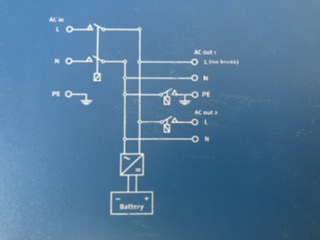Hi All,
I need some solid engineering input on this question of making input and output inverter/charger neutrals common. I have seen the Common Neutral thread which is for a different application. This is a static application situation - a problem I have been battling with for over 6 years on all my projects.
It is essential to state the two key problem causes and why they are not solvable:
1. Our municipal grid has been degrading severely over the last 30 years with poor maintenance causing neutral disconnections and ground-neutral bonding issues on the utility/transformer side. This is getting worse due to utility having little finance and incompetent maintenance staff.
2. House wiring standards are not adhered to in many site cases meaning joins on neutral in ceilings/conduits for multiple electrical circuits. Or missing neutrals. To fix this (compliance issue) takes up a huge amount of time which customers are mostly not willing to pay for so I have found myself working hours, days, weeks and months for free to sort out these issues. Why is this a problem? Apart from the obvious electrical problems and neutral overloading, in my country customers cant afford to go off-grid so we split the house wiring into "inverter powered" and "grid powered" circuit (btw: we have daily power outages everywhere). Which means inevitably we will have a neutral fault or a common neutral somewhere in the wiring due to these non-compliant situations. So it may be worth common-ing inverter and grid neutral in the main distribution to "draw" the connection off house wiring - just a thought as the worst thing is to power a circuit without a neutral - our utility conditions has done us the honor of doing the "hands-on" test for us - to the detriment of equipment or lots of SPDs.
So my question: Is there any electrical compromise I can look into? - to stop me from sponsoring customer's compliance because of the nasty 80% of electricians who cheat and make lots of money.
Maybe some specific protective device or solution including common neutral, a specific SPD? some RCD that works -
* a 30mA RCD is not an option - electricians bypass them because of continuous tripping.
* off grid not an option as customers can't afford it.
* redoing site wiring not an option because customers can't/ don't want to afford it
* me quitting the business is a less than ideal situation as with 90% unemployment rate in my country other lines of work are just as difficult.
So to all the engineers out there who like solving problems please HELP! :D
P.S. I'm an Electrical/Electronics Engineer with more knowledge in Electronics than Electrical Power - I have fair experience with the effect of surges and earthing issues in electronics ;)
Kenyon

